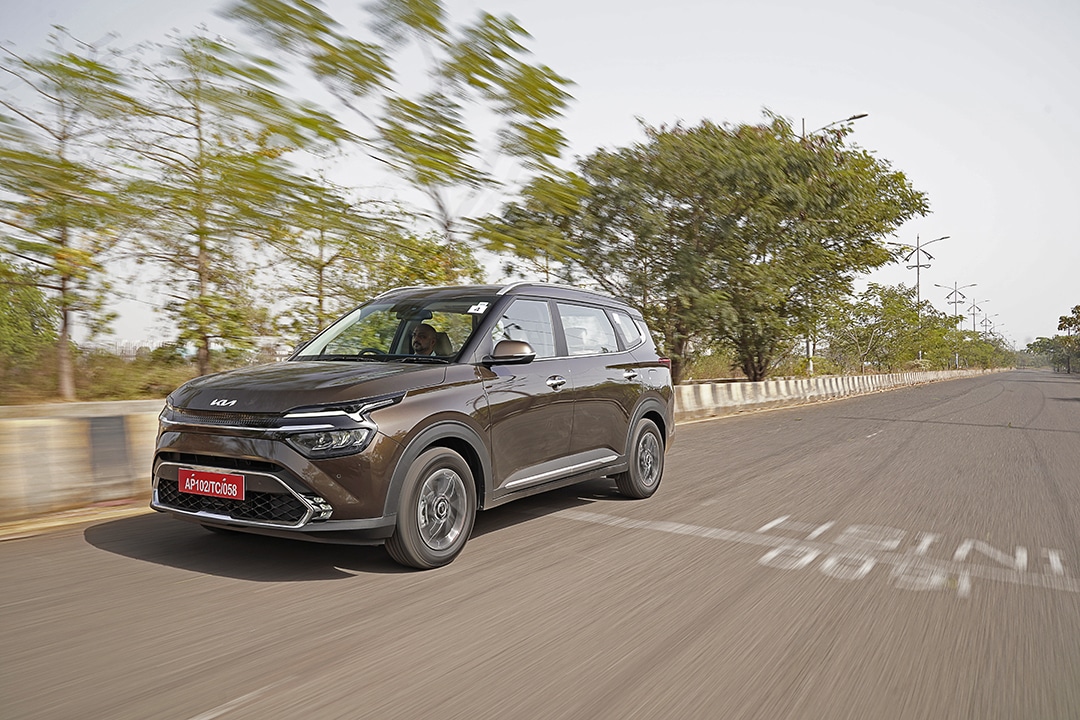The Kia Carens is the third India-specific model from Kia India and it promises spacious three rows of seats, multiple powertrain options and loads of convenience and features.
[metaslider id=31419]
Story: Sarmad Kadiri
Photography: Sanjay Raikar
Despite being based on a stretched Seltos platform, with a 160-millimetre longer wheelbase, the Kia Carens looks nothing like its sibling. The new model is being marketed as a ‘Recreational Vehicle’, one that offers SUV-like appeal and an MPV’s practicality.
Kia Carens: Design
The Kia Caren looks very unique, especially from the front. The electric-car like front with a completely shut grille a distinct face and there’s a glossy black strip with 3D texturing that reflects light interestingly. Kia have executed the split LED headlamp set-up really well. The arrow-shaped daytime running lights (DRL) also act as turn indicators and are highlighted with neat black accents, while the low-set headlamps are positioned on the bumper. What also looks striking is now the signature ‘Tiger Nose’ is integrated into the bumper (instead of the grille) and doubles as an air-dam.
In profile, till the B-pillar, there are traces of the Seltos, though the rest of the car looks very different. The rear doors are larger as they give access to the second- and last-row seats. It also gets a fair amount of chrome, right from the tiger-nose upfront to the door-handles and accents on the window-line. There is a good use of plastic cladding which not just gives it an SUV-ish appearance but also disguises the smaller 16-inch wheels (the top-end Alcazar gets 18-inch wheels). Obviously, larger wheels would’ve looked even better, but smaller wheel-arches mean more cabin room. Then the big windows and quarter glass create an airy cabin. A prominent shoulder-line starts from the front headlamp and gradually blends into the body and then re-emerges near the wrap-around LED tail-lamp. The compact rear styling is more MPV-ish, though robust bumper design and aggressive use of chrome do lend a touch of SUV as well. And that’s something which can be said about the overall design too.
Kia Carens: Dimensions
It’s a pretty large car and one only realises this when viewed from the side. In fact, the Kia Carens is even larger than the Hyundai Alcazar, being longer by 40 mm, 10 mm wider, and taller by 25 mm and the 20-mm longer wheelbase helps carve out that crucial bit of cabin space, especially for the third row. While comparing the dimensions, what blew us away is that the Kia Carens’ wheelbase is slightly longer than the mighty Innova Crysta’s, though the Toyota is longer overall.
Kia Carens: Cabin / Interior
Like other Kia models, the cabin looks distinct and well-appointed and it has the right touch of premium-ness. Our test car came in an interesting cream-and-navy-blue combination and the overall fit-and-finish looked impressive. The visibility from the driver’s seat is also good, the blue faux leather-wrapped steering is adjustable for tilt and reach, and, though not electrically powered, the front seats can be adjusted to suit your liking. The multi-layer dashboard comes with nice-looking detailing, while the 10.25-inch touchscreen is neatly integrated into it and is slightly angled towards the driver for a clearer view.
Even the a-c vents are seamlessly integrated into the dashboard; there are touch-panels to control the blower and switches for climate control. Driving modes (in the automatic versions) and seat ventilation get dedicated buttons on the centre console. Surprisingly, the driver’s information display, though all-digital, is a simpler unit than the one seen in the Alcazar. On the whole, the cabin exhibits a clever use of space with plenty of cubbyholes. Apart from the usual, there’s a retractable cup-holder for the front passenger, a nifty seat storage tray under the front passenger seat, and a slide-out ticket tray for the driver. Even the cup-holders for the front and middle rows come with ventilation. And there’s a wireless charging pad for smartphones.
Kia Carens: Three Row Seating
The standard versions are available in a seven-seat configuration, with bench-type seating in the second row. The top-end trims can be had in a more comfortable six-seater option. I can vouch for the Captain seats, as they are really comfortable with ample leg-room. They recline and can slide back and come with folding arm-rests. Thanks to the large windows one gets a good outside view and, for privacy, there are retractable sunshades. The all-important middle left seat offers added convenience like a foldable tray to place your gadgets on. It is quite a comfortable place to be in, plus one gets a couple of USB Type-C chargers and ample storage area.
Another talking point are the roof-mounted a-c vents, which not just look good but do a good job of channelling air through the cabin. This, however, doesn’t leave space for a panoramic sunroof, but there’s a smaller one if you’re into stargazing. A car of this size needs a large air-purifier which had to be moved from the usual centre arm-rest to the back of the driver’s seat. So, those seated here get limited knee-room, while the constant hum from the unit can get on the driver’s nerves during long journeys.
In our top-spec Luxury Plus version, the left Captain seat topples and tumbles with the press of a button, a segment-first. Being electrically powered, you don’t have to make any effort at all. Sliding into the third row isn’t a fight and the space there isn’t as restrained. In fact, they offer better comfort than most other three-row cars. The back-rest can be reclined to make things more accommodating and, with the second row not too far back, even adults have little to complain about. The large quarter glass, roof-mounted vents, and decent all-round visibility ease things out further. Making longer journeys more comfortable are features like USB Type-C chargers and cup-holders at the back too. Right at the back, even with all the three rows occupied, you get a decent 216-litre luggage space, enough for some vanity bags and briefcases. Plus, the flexibility of folding the split third-row opens up 645 litres of cargo room; toppling down the second and third rows frees up a generous 1,164 litres.
Kia Carens: Features
Kia India have always packaged their cars well and the Carens has a decent kit onboard too. So, on higher trims, there’s a Bose sound system, infotainment system with connected features, 64-colour ambient lighting, rear-view camera, and front sensors, with the focus on safety features like front and rear disc brakes, six airbags as standard, ABS, ESC, hill-start, and tyre pressure monitoring system. Since most buyers will also consider the Alcazar, they’ll notice that the Kia misses out on electrically powered front seats, a panoramic sunroof, 360-degree camera, and blind-spot view monitor which the Hyundai offers.
Kia Carens: Engine and Performance
To give buyers ample choice, the Carens gets two petrol and one diesel engine options, offered in manual and automatic gearbox combinations, as on the Seltos. The smooth and sporty 1.4-litre turbo-petrol makes 140 hp and 242 Nm and is quick off its feet. Post 1,600 rpm is when the fun begins and this turbo-charged unit likes to be revved hard. But you can feel the additional workload on the engine, especially when the three rows of seats are fully occupied. The automatic shifts are seamless and make things rather easy. However, the seven-speed dual-clutch transmission has been tuned for comfort and convenience and isn’t as responsive as in the Seltos. You do get driving modes, too, and shifting to Sport does improve things slightly. The formula to Carens is — drive it gently and get the best out of this recreational vehicle.
We feel torquey and efficient diesel engines are more apt for a recreational vehicle like this, which will be the weapon of choice for intercity trips. So, we also tested Kia’s 1.5-litre diesel which produced 115 hp and 250 Nm of peak torque. The numbers might not seem very impressive on paper, but, as proved by the Alcazar, the oil-burner doesn’t disappoint even with the extra row of seating. Driving the six-speed manual version of the Carens also helped this cause, because, apart from the smooth and precise shifts, one also gets full control. That’s why during regular city use it never feels wanting or underpowered and makes overtaking in higher gears an easy chore. And on highways, it effortlessly cruises at three-digit speeds, with the revs kept comfortably below 2,000 rpm. Yes, with a full house and on steep inclines the 1.5-litre diesel will seem more stressed than usual, but manage the gears well and it chugs along none the less.
Kia Carens: Ride and Handling
What makes the Carens more desirable is that it’s just so easy to drive around. While manoeuvring it through traffic or on winding roads, it feels so manageable and much smaller than it actually is. Things like good all-round visibility, a light clutch, and a well-weighted steering play a big part here. The thing about the steering is that though it feels light and easy during U-turns and parking, it doesn’t feel disconnected at high speeds. Adding to it is the well-controlled body movement and predictable road manners. This also makes the Carens more engaging to drive than some of its competitors and also safer during sudden changes of directions. Passengers, especially those in the third row, will truly appreciate the limited rolling and wallowing. The suspension, in spite of being firm enough, does a fine job of filtering out road undulations at low speed, making the journey more comfortable for all. With 195 mm of ground clearance and a well-balanced suspension, the Kia doesn’t lose composure over a bad patch of road even at high speed. This helps cement the driver’s confidence with the vehicle further.
Kia Carens: Launch Price
So far, Kia models have been priced smartly and we’re sure they won’t disappoint with the Kia Carens either. It’s one of the most well-rounded three-row cars in the market with an expected price between Rs 14 and 18 lakh. With its neat styling, well-appointed cabin, adequate features, and very usable third row, the Carens seems like yet another blockbuster from the South Korean brand.






















Leave a Reply